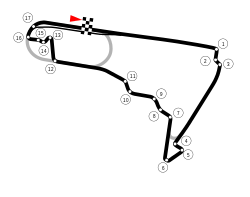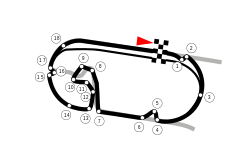Autódromo Hermanos Rodríguez
  The Hermanos Rodríguez Grand Prix circuit. | |
| Location | Mexico City, Mexico |
|---|---|
| Time zone | UTC-6, (DST: UTC-5) |
| Coordinates | 19°24′22″N 99°5′33″W / 19.40611°N 99.09250°W |
| Capacity | 110,000 |
| FIA Grade | 1 |
| Major events | FIA Formula One Mexican Grand Prix (1962–1970, 1986–1992, 2015–present)
Trofeo Mexico (430 km) (1989–1991) |
| Website | http://ahr.notiauto.com |
| F1 Grand Prix circuit (2015–present)[1] | |
| Surface | Asphalt |
| Length | 4.304[1] km (2.674 miles) |
| Turns | 17[1] |
| Race lap record | 1:18.785 ( |
| CART Grand Prix circuit (2002–2014) | |
| Surface | Asphalt |
| Length | 4.484 km (2.786 miles) |
| Turns | 17 |
| Race lap record | 1:24.713 ( |
| F1 Grand Prix circuit (1986–2001) | |
| Surface | Asphalt |
| Length | 4.421 km (2.747 miles) |
| Turns | 14 |
| Race lap record | 1:16.788 ( |
| Short Grand Prix circuit (1980–1985) | |
| Surface | Asphalt |
| Length | 3.991 km (2.480 miles) |
| Turns | 9 |
| Original Grand Prix circuit (1962–1979) | |
| Surface | Asphalt |
| Length | 5.000 km (3.107 miles) |
| Turns | 14 |
| Race lap record | 1:43.05 ( |
| NASCAR circuit (2005–2014) | |
| Surface | Asphalt |
| Length | 4.052 km (2.518 miles) |
| Turns | 16 |
| Race lap record | 1:27.458 ( |
| Oval circuit (1962–present) | |
| Surface | Asphalt |
| Length | 1.609 km (1.000 miles) |
| Turns | 4 |
| Formula E Circuit (2016–present) | |
| Surface | Asphalt |
| Length | 2.092 km (1.300 miles) |
| Turns | 18 |
| Race lap record | 1:03.102 ( |
The Autódromo Hermanos Rodríguez is a 4.304 km (2.674 mi) motorsport race track in Mexico City, Mexico, named after the racing drivers Ricardo and Pedro Rodríguez. The circuit got its name shortly after it opened when Ricardo Rodríguez died in practice for the non-Championship 1962 Mexican Grand Prix. Ricardo's brother Pedro also lost his life behind the wheel nine years later. Since 2015 the track once again is a host of the Formula One Mexican Grand Prix, an event it previously hosted in two separarate time periods on a different layout, the last occasion of which was in 1992.
The circuit is located within the public park of the Magdalena Mixhuca Sports City in southeast Mexico City. The circuit is owned by the Government of the City, but is currently operated under concession by Corporación Interamericana de Entretenimiento (CIE) through OCESA, one of CIE's subsidiaries. CIE also organizes the NASCAR and Desafío Coron races in this circuit and rents the circuits to other parties, including race organizers, automobile clubs and track amateurs for fees that are controversial due to their disproportionately high amounts compared to other ex-F1 courses.
The NASCAR Xfinity Series started racing at Autódromo Hermanos Rodríguez in the 2005 season and ended in the 2008 season. Martin Truex Jr. won the race in 2005, and Denny Hamlin won in 2006. For the 2007 race, the chicane was removed to increase passing opportunities down the front straight and into turn 1, and Juan Pablo Montoya from Bogotá, Colombia, won the race. Kyle Busch was the winner of the race in 2008.
The A1 Grand Prix series started racing at Autódromo Hermanos Rodríguez in the 2006–07 season using the full-track configuration used by Formula One. Alex Yoong from Malaysia won the sprint race and Oliver Jarvis from the United Kingdom won the feature race. In the 2007–08 season, Jonny Reid from New Zealand won the sprint race and Adam Carroll of Team Ireland won the feature race.
History
Built in a public park in 1959, the circuit hosted its first Formula One Grand Prix in 1962, as a non-Championship race. The following year the Mexican Grand Prix became a full World Championship event. The circuit remained part of the F1 calendar through 1970, when spectator overcrowding caused unsafe conditions. When the track re-opened in 1986, the circuit boasted a new pit complex, as well as improved safety all around. In 2001 CIE and Forsythe Racing tasked D3 Motorsport Development with revamping the circuit. A redesign to include the Foro and a complete upgrade of the circuit was done. It saw a record crowd of 402,413 people attend a round of the CART Championship in 2002. As of 2018, the Autódromo Hermanos Rodríguez has been the only venue for the F1 Mexican Grand Prix.
It was announced in May 2012, that the circuit would again host the Mexican Grand Prix from 2013, in a five-year deal that would see it replace the European Grand Prix in Valencia,[2] but this did not happen. The FIA listed the Mexican Grand Prix as the 19th round of the provisional schedule for the 2014 season,[3] but it was not on the finalized schedule. The Mexican Grand Prix was listed on the 2015 Formula One calendar published by the FIA on 3 December 2014, with Formula One making its return to the circuit with the race on 1 November 2015.[4]
The racetrack is also home to Insomnniacs Electric Daisy Carnival (EDC Mexico) a popular music festival and experience attended by over 200,000 people.[5]
The Grand Prix circuit

The circuit has an elevation of 2,285 m (7,500 ft); the thin air causes difficulties for both the drivers and their cars.
The circuit has an extremely fast final corner (the Peraltada, turn 17) before a long start/finish straight, and thus reminded some of Monza; however, unlike Monza's parabolica curve, the Peraltada curve is slightly banked, allowing even more speed through the corner. It was at this corner that the younger Rodríguez crashed, due to suspension failure. After the last F1 Mexican Grand Prix in 1992, a baseball stadium called the "Foro" was built on the inner part of this curve. When the Champ Car series began using the track in 2002, the Peraltada curve was partially bypassed by a series of sharp turns entering and exiting the Foro; re-entering the Peraltada halfway through.
After the Peraltada comes the long 1.2 km front straight. During the original turbo era in Formula One the faster cars were regularly clocking speeds of up to 330 km/h (205 mph) on the straight.
In the 2005 NASCAR Busch Series season, there was a chicane on the main straightaway to slow the cars down. They also introduced a curve between the short course and the Ese del Lago to bypass the latter, but avoiding the stadium detour.
The Grand Prix circuit underwent a significant renovation under the direction of Hermann Tilke for the return of Formula One in 2015. The front straight was slightly extended and reprofiled to accommodate a new media center and paddock. The iconic esses between turns 7 and 13 were significantly modified; the prolific, high radius turns largely diminished and some replaced with fixed angle turns. The baseball field portion of the track was also altered to a low speed left-right combination that bypassed the first half of the Peraltada, allowing the cars to re-enter the Peraltada halfway through the corner. At 4.304 kilometres (2.674 mi), the course is 170 metres (560 ft) shorter than the previous Grand Prix layout, and Mexican Grand Prix organisers predicted lap times of around 75 seconds and speeds in excess of 328 km/h (204 mph) for the current turbocharged Formula One cars, which eliminate the adverse effects of altitude present in naturally aspirated cars.[1] However it turns out the modern V6 hybrid turbo F1 cars managed to reach the top speed in excess of 370 km/h (230 mph) down the main straight.
The oval track



The circuit also features an oval layout due to the inclusion of a flat turn that goes from the middle of the main straight to the beginning of the back stretch of circuit. Unlike the road course, the oval is raced in counter-clockwise direction (except for the Formula E race).
The oval configuration of this Mexico City facility is arguably the most dangerous racetrack in Mexico, because of the limited visibility at the exit of Turns 2 and 4. This is because the Foro Sol baseball stadium is located inside turns 1 and 2; and several trees are located inside turns 3 and 4.
During the 2006 season, two accidents occurred in the oval track during NASCAR Mexico T4 Series events, which took several drivers out of the race and even required some of them to be taken to hospital.
The oval configuration is used at least twice a year, with two double-feature events featuring the NASCAR Toyota Series and the NASCAR Mexico T4 Series.
The oval configuration also forms the base of the FIA Formula E Championship circuit for the Mexico City ePrix; the oval is raced clockwise, but there is a chicane that will be used prior to the entrance of Turn 4, with a second chicane on the backstretch, followed by a modified Foro Sol section that exits for the full Peraltada, and a third chicane will be placed midway through the Peraltada (Turns 1 and 2 of the oval). FIA Formula E track design was modified by Agustin Delicado Zomeño.
Renamed turns
In 2015 the Turn 17 of the Autodromo Hermanos Rodríguez was baptized in honour of Formula One legend Nigel Mansell, twice winner of the Mexican Grand Prix of 1987 and 1992.[6]
On September 20, 2016 Adrián Fernández's achievements have been recognised by the naming of Turn 12 of the Autodromo in his honour.[7]
Current races
- Copa Turismo México – Copa Turismo México Presentada por Continental y FIAT
- Moto Pro México – Copa Turismo México Presentada por Continental y FIAT
- Formula One – Mexican Grand Prix
- Formula E – Mexico City ePrix
- FIA World Endurance Championship - 6 Hours of Mexico
The baseball stadium
The Autódromo is unique in the sense that there is a baseball stadium inside Turn 14 (Peraltada). The stadium, called Foro Sol, was home to the Diablos Rojos del México, and also hosts music concerts.
Artists like Iron Maiden, Paul McCartney, Metallica, Pink Floyd, Santana, The Rolling Stones, Madonna, Stone Temple Pilots, Nine Inch Nails, U2, and Radiohead are just a few of the names that have played there.
The Coca-Cola Zero Festival was held at the racetrack on 12 April 2008 [1]. Acts included The Smashing Pumpkins, The Mars Volta, My Chemical Romance, My Morning Jacket, Belanova, Bright Eyes, Kinky and Miranda!.
References
- ^ a b c d "FORMULA 1 GRAN PREMIO DE MÉXICO 2015". Archived from the original on 15 October 2015. Retrieved 10 October 2015.
{{cite web}}: Unknown parameter|deadurl=ignored (|url-status=suggested) (help) - ^ "México tendrá gran premio ya para 2013". MARCA.com. Retrieved 30 May 2012.
- ^ "2014 Calendar draft has 21 races including Mexico". f1fanatic.co.uk. Retrieved 5 September 2013.
- ^ "World Motor Sport Council 2014 - Doha". FIA. 3 December 2014. Archived from the original on 19 March 2015. Retrieved 22 December 2014.
{{cite web}}: Unknown parameter|deadurl=ignored (|url-status=suggested) (help) - ^ "TRAVEL - EDC Mexico 2018". electricdaisycarnival.com. Retrieved 13 February 2018.
- ^ "Mexico names final corner after Nigel Mansell". formula1.com. Retrieved 13 February 2018.
- ^ "Adrian Fernandez has corner named after him in Mexico City". motorsport.com. Retrieved 13 February 2018.
External links
- Official website
- Autódromo Hermanos Rodríguez Page at GrandPrix.com (focusing on Formula One history)
- Autódromo Hermanos Rodríguez on Google Maps
